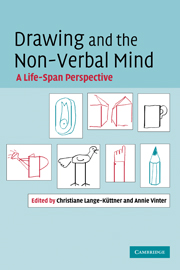1 - Contemporary enquiries into a long-standing domain: Drawing research
Published online by Cambridge University Press: 22 September 2009
Summary
drawing behaviour has occupied European psychologists from the turn of the last century (Kerschensteiner, 1905; Luquet, 1927; Ricci, 1887; Rouma, 1913), maintained their interest ever since, and subsequently also attracted some attention from psychologists in other continents such as the United States. The main contribution of the early work was to describe how this typically human behaviour develops, and in particular which stages it follows (Piaget and Inhelder, 1956). Still, perhaps like many other scientists nowadays, Piaget saw drawing only as a figurative, illustrative instrument of representation, as opposed to rational and operational thought devoted to the genuine understanding of reality. Thus, drawing behaviour was not frequently studied in relation to cognitive development. However, a notable exception was the ‘Draw-a-person test’ designed by Goodenough (Goodenough, 1926; Goodenough and Harris, 1950) which assesses mental age in children via the human figure drawing, and, because it has a high correlation with intelligence tests until adolescence, it is still in use today.
Since the 1970s and 1980s, a refreshed interest in drawing from developmental and cognitive psychologists from an empirical, experimental, statistically underpinned perspective has flourished, as evident in two books by Freeman (Freeman, 1980, see also his current contribution to this book; Freeman and Cox, 1985).
- Type
- Chapter
- Information
- Drawing and the Non-Verbal MindA Life-Span Perspective, pp. 1 - 20Publisher: Cambridge University PressPrint publication year: 2008
References
- 1
- Cited by



